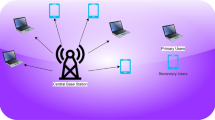Abstract
Current Network Management paradigms are rigid and lack flexibility. This makes the task of managing a highly evolving and dynamic network difficult to cope with. This paper presents the results of our work on Agent technology as a new paradigm for developing Network Management applications. First, we present our agent architecture that is built in a way that allows the agent to acquire new capabilities at runtime. Second, we present two case studies implemented with a prototype of this agent architecture. The first case study consists of an agent system in which faulty agents are automatically detected, their tasks then being reallocated to other agents, thus providing a fault-tolerant management system. The second case study deals with the configuration of heterogeneous ATM networks to establish end-to-end permanent virtual channels. Finally, we evaluate our agent architecture and the agent paradigm in general when applied to Network Management.
Similar content being viewed by others
REFERENCES
Agent communication language. http://www.fipa.org/spec/fipa9712.pdf, 1999.
Mobile Agent Facility formal specification, Object Management Group TC Document, cf/00-01-02, (January, 2000).
A. L. Hayzelden and J. Bigham, Agent technology in communications systems: An overview, Knowledge Engineering Review, Vol. 14, No. 4, pp. 341–375, 1999.
M. Cheikhrouhou, P. Conti, R. T. Oliveria, and J. Labetoulle, Intelligent agents in network management, a state of the art, Networking and Information Systems, Vol. 1, No. 1, pp. 9–38, 1998.
S. Albayrak and F. J. Garijo, (eds.), Proceedings of the Second International Workshop on Intelligent Agents for Telecommunications Applications, IATA'98, No. 1699 in Lecture Notes in Artificial Intelligence, Berlin, Springer, June 1998.
M. Wooldridge and N. R. Jennings, Intelligent agents: Theory and practice, Knowledge Engineering Review, Vol. 10, No. 2, pp. 115–152, 1995.
H. S. Nwana, Software agents: An overview, Knowledge Engineering Review, Vol. 11, pp. 205–244, October/November 1996.
M. Plu, Software technologies for building agent-based systems in telecommunications networks. In N. R. Jennings and M. J. Wooldrige, (eds.), Agent Technology: Foundations, Applications and Markets, Springer-Verlag, 1998.
J. P. Müller, The Design of Intelligent Agents—A Layered Approach, LNAI State-of-the-Art Survey, Berlin, Germany, Springer, 1996.
R. Oliveira and J. Labetoulle, Intelligent agents: A new management style, in Proceedings of the Distributed Systems and Operations Management Workshop—DSOM'96, L'Aquila, Italy, October 1996.
M. M. Cheikhrouhou, BDI-oriented agents for network management, in Proceedings of Globecom'99, Rio de Janeiro, Brazil, IEEE, December 1999.
T. Magedanz, On the impact of intelligent agents concepts on future telecommunication environments, in Third International Conference on Intelligence in Broadband Services and Networks, Crete, Greece, Octobr 1995.
C. Bäumer and T. Magedanz, Grasshopper—a mobile agent platform for active telecommunication networks, In S. Albayrak, (ed.), Intelligent Agents for Telecommunication Applications No. 1699 in Lecture Notes in Artificial Intelligence, Stockholm, Sweden, Springer, pp. 19–32, August 1999.
T. White, B. Pagurek, and A. Bieszczad, Network modeling for management applications using intelligent mobile agents, Journal of Network and Systems Management, Vol. 7, No. 3, pp. 295–321, September 1999.
P. Bellavista, A. Corradi, and C. Stefanelli, An open secure mobile agent framework for systems management, Journal of Network and Systems Management, Vol. 7, pp. 323–339, September 1999.
M. Wooldrige, Barriers to the industrial take-up of agent technology, in The Practical Application of Intelligent Agents and Multi-Agent Technology, London, p. 11, The Practical Application Company Ltd, April 1999.
G. Weiss, (ed.) Multiagent Systems: A Modern Approach to Distributed Artificial Intelligence, Cambridge, Massachussetts: The MIT Press, 1999.
M. P. Singh, A. S. Rao, and M. P. Georgeff, Multiagent Systems: A Modern Approach to Distributed Artificial Intelligence, The MIT Press, pp. 331–376, 1998.
Y. Labrou and T. Finin, A proposal for a new KQML specification. Computer Science and Electrical Engineering Department, University of Maryland Baltimore County, Baltimore, Maryland, February 1997. http://www.cs.umbc.edu/kqml/papers/.
T. Finin and G. Wiederhold, An overview of KQML: A knowledge query and manipulation language, 1991. Available through the Stanford University Computer Science Dept.
J. R. Searle, Speech Acts: An Essay in the Philosophy of Language, Cambridge University Press, 1970.
M. Barbuceanu and M. S. Fox, The design of a coordination language for multi-agent systems, Intelligent Agents III. Agent Theories, Architectures, and Languages, Springer, pp. 341–355, 1996.
M. Wooldridge, Intelligent agents. In G. Weiss, (ed.), Multiagent Systems: A Modern Approach to Distributed Artificial Intelligence, Cambridge, Massachusetts, The MIT Press, 1999.
N. Skarmaeas and K. L. Clark, Process oriented programming for agent-based network management, in ECAI96 Workshop on Intelligent Agents for Telecommunication Applications (IATA96), Budapest, Hungary, August 1996.
J. Meinkohn and S. Albayrak, Future IN-platforms with agent technology. In S. Albayrak and F. J. Garijo (eds.), Lecture Notes in Artificial Intelligence, Springer p. 80, June 1998.
G. Berthet, Extension and Application of System-level Diagnosis Theory for Distributed Fault Management in Communication Networks. Ph.D. thesis, École Polytechnique Fédérale de Lausanne, Lausanne, CH, 1996.
S. Hakimi and K. Nakajima, On adaptive system diagnosis, IEEE Transactions on Computers, Vol. C-33, pp. 234–240, March 1984.
F. P. Preparata, G. Metze, and R. T. Chien, On the connection assignment problem of diagnosable systems, IEEE Transactions on Electronic Computers, Vol. EC-16, pp. 848–854, December 1967.
M. M. Cheikhrouhou, P. O. Conti, and J. Labetoulle, Flexible software agents for the automatic provision of PVCs in ATM networks, in Section IFIP WG 6.1 International Working Conference on Distributed Applications and Interoperable Systems, Helsinki, Finland, 1999.
B. Pagurek, Y. Li, A. Bieszczad, and G. Susilo, Network configuration management in heterogeneous ATM environments. In S. Albayrak and F. J. Garijo, (eds.) Intelligent Agents for Telecommunication Applications—IATA'98 No. 1437 in Lecture Notes in Artificial Intelligence, Paris, France, July 1998.
K. Tesink and T. Brunner, (Re)Configuration of ATM virtual connections with SNMP, The Simple Times, Vol. 3, August 1994.
Author information
Authors and Affiliations
Rights and permissions
About this article
Cite this article
Cheikhrouhou, M.M., Conti, P., Marcus, K. et al. A Software Agent Architecture for Network Management: Case Studies and Experience Gained. Journal of Network and Systems Management 8, 349–372 (2000). https://doi.org/10.1023/A:1009482204363
Issue Date:
DOI: https://doi.org/10.1023/A:1009482204363




